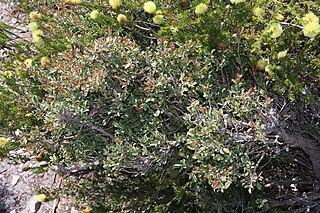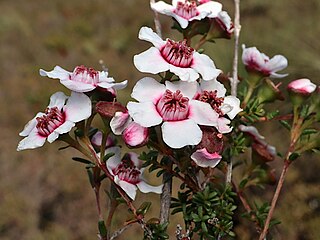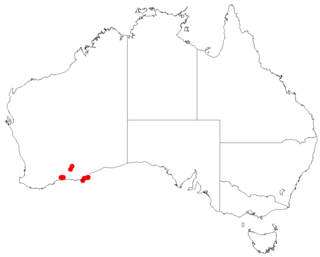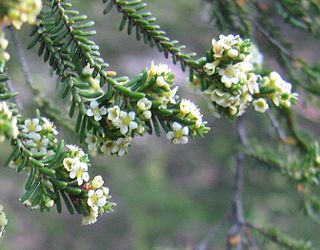
Beaufortia empetrifolia, commonly known as south coast beaufortia, is a plant in the myrtle family, Myrtaceae and is endemic to the southwest of Western Australia. It is a highly branched shrub with small, crowded leaves and pinkish to purple flowers in small, bottlebrush-like spikes in the warmer months. It is similar to Beaufortia micrantha except that its leaves are slightly larger.

Agonis baxteri is a species of flowering plant in the family Myrtaceae and is endemic to the southwest of Western Australia. It is an erect, sometimes bushy shrub with elliptic to egg-shaped leaves with the narrower end towards the base, and usually white flowers with 23 to 32 stamens.

Agonis undulata is a species of flowering plant in the family Myrtaceae, and is endemic to the Fitzgerald River National Park in the south of Western Australia. It is an erect shrub with more or less sessile, egg-shaped leaves with the narrower end towards the base, white flowers, and broadly cup-shaped capsules.
Balaustion grande is a species of flowering plant in the family Myrtaceae and is endemic to the south-west of Western Australia. It is a low-growing shrub with oblong or narrowly oblong leaves and usually white or pale pink flowers with 16 to 28 stamens fused in a ring.
Austrobaeckea latens is a species of flowering plant in the family Myrtaceae and is endemic to the south of Western Australia. It is an upright, spreading shrub with erect, linear leaves and small white flowers with three to ten stamens.
Austrobaeckea pachyphylla is a species of flowering plant in the family Myrtaceae and is endemic to the south of Western Australia. It is a shrub with bilaterally flattened leaves and small white flowers with two to eight stamens.
Austrobaeckea pygmaea is a species of flowering plant in the family Myrtaceae and is endemic to the south-west of Western Australia. It is a slender and erect or spreading shrub with narrowly egg-shaped to almost linear leaves and small white flowers with 12 to 25 stamens.

Calytrix asperula, commonly known as brush starflower, is a species of flowering plant in the myrtle family Myrtaceae and is endemic to the south of Western Australia. It is a mostly glabrous shrub with linear to narrowly elliptic leaves and cream-coloured to yellow flowers with 40 to 60 yellow stamens in several rows.

Calytrix oldfieldii is a species of flowering plant in the myrtle family Myrtaceae and is endemic to the south-west of Western Australia. It is a glabrous shrub with linear, oblong or egg-shaped leaves and mauve, pink, red, magenta or violet flowers with about 50 to 75 yellow stamens in several rows.

Micromyrtus elobata is a species of flowering plant in the myrtle family, Myrtaceae and is endemic to the south of Western Australia. It is usually an erect shrub with small, narrowly to broadly egg-shaped leaves with the narrower end towards the base, and white flowers 3–5 mm (0.12–0.20 in) in diameter.
Micromyrtus imbricata is a species of the family Myrtaceae and is endemic to the south of Western Australia. It is a slender, erect shrub with broadly egg-shaped leaves, white, pink or red-tinged flowers 4–5 mm (0.16–0.20 in) in diameter, and 10 stamens.

Micromyrtus racemosa is species of the flowering plant in the family Myrtaceae and is endemic to the south-west of Western Australia. It is a shrub with relatively thick, narrowly egg-shaped leaves, sometimes with the narrower end toward the base, and white, cream-coloured or yellow flowers 2.5–4.0 mm (0.098–0.157 in) in diameter.

Thryptomene australis, commonly known as hook-leaf thryptomene, is a species of flowering plant in the family Myrtaceae and is endemic to the south-west of Western Australia. It is an erect, bushy and spreading shrub with upward-pointing leaves with the tip curving outwards, and flowers with white petals arranged spike-like near the ends of the branchlets.

Babingtonia camphorosmae, commonly known as camphor myrtle, is a species of flowering plant in the family Myrtaceae and is endemic to the southwest of Western Australia. It is a prostrate to low-growing shrub with linear to thread-like leaves and white or pink flowers in groups of up to five, each flower with ten to thirteen stamens.

Babingtonia grandiflora, commonly known as the large flowered babingtonia, is a species of flowering plant in the family Myrtaceae. It is a common heathland shrub endemic to the coastal southwest of Western Australia. It is a shrub with erect or arching stems, linear leaves and white or pale pink flowers usually arranged singly in leaf axils, each flower with 11 to 25 stamens. Babingtonia grandiflora flowers from August to December.

Stachystemon polyandrus is a species of flowering plant in the family Picrodendraceae and is endemic to the southwest of Western Australia. It is a diffuse to straggling, monoecious shrub with crowded, oblong, elliptic or egg-shaped leaves with the narrower end towards the base, and small yellowish-white flowers arranged singly in upper leaf axils, but forming clusters at the ends of branches.

Daviesia aphylla is a species of flowering plant in the family Fabaceae and is endemic to the south-west of Western Australia. It is an erect, bushy shrub with glabrous foliage, up to six sharply-pointed phyllodes on each branchlet, and orange-red and yellow flowers.

Daviesia microphylla is a species of flowering plant in the family Fabaceae and is endemic to the south-west of Western Australia. It is an openly-branched, sprawling shrub with spiny branchlets, crowded, sharply-pointed, egg-shaped phyllodes, and orange, dark red and maroon flowers.

Leucopogon bossiaea is a species of flowering plant in the heath family Ericaceae and is endemic to a restricted area in the south-west of Western Australia. It is an erect shrub with elliptic to broadly egg-shaped leaves and white flowers in four to eleven upper leaf axils.

Micromyrtus hexamera is a species of flowering plant in the myrtle family, Myrtaceae and is endemic to Queensland. It is a shrub with erect or spreading branchlets, overlapping linear leaves, and white flowers arranged singly in leaf axils with 5 stamens in each flower.















